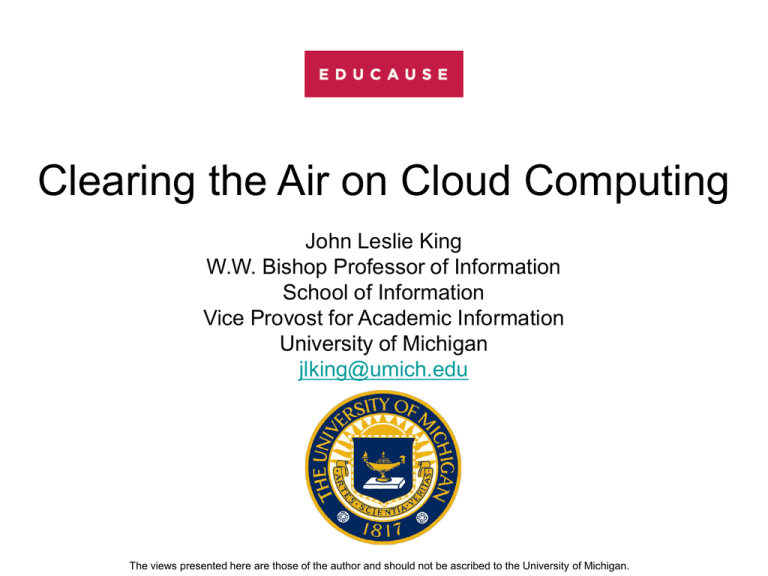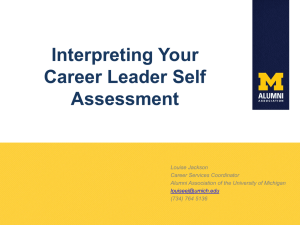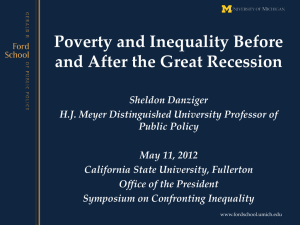Clearing the Air on Cloud Computing
advertisement

Clearing the Air on Cloud Computing John Leslie King W.W. Bishop Professor of Information School of Information Vice Provost for Academic Information University of Michigan jlking@umich.edu The views presented here are those of the author and should not be ascribed to the University of Michigan. The views presented here are those of the author and should not be ascribed to the University of Michigan. jlking@umich.edu 2 2008 Cloud computing http://techcrunch.com/2008/08/18/where-are-we-in-the-hype-cycle/ jlking@umich.edu 3 2009 http://www.gartner.com/it/page.jsp?id=1124212 “Cloud Computing. As enterprises seek to consume their IT services in the most cost-effective way, interest is growing in drawing a broad range of services (for example, computational power, storage and business applications) from the "cloud," rather than from on-premises equipment. The levels of hype around cloud computing in the IT industry are deafening, with every vendor expounding its cloud strategy and variations, such as private cloud computing and hybrid approaches, compounding the hype.” jlking@umich.edu 4 “Cloud Computing refers to both the applications delivered as services over the Internet and the hardware and systems software in the datacenters that provide those services. The services themselves have long been referred to as Software as a Service (SaaS). The datacenter hardware and software is what we will call a Cloud. When a Cloud is made available in a pay-as-you-go manner to the general public, we call it a Public Cloud; the service being sold is Utility Computing. We use the term Private Cloud to refer to internal datacenters of a business or other organization, not made available to the general public. Thus, Cloud Computing is the sum of SaaS and Utility Computing, but does not include Private Clouds.” (pg. 1) http://www.eecs.berkeley.edu/Pubs/TechRpts/2009/EECS-2009-28.pdf jlking@umich.edu 5 “Bubble memory is a type of non-volatile computer memory that uses a thin film of a magnetic material to hold small magnetized areas, known as bubbles or domains, each of which stores one bit of data. Bubble memory started out as a promising technology in the 1970s, but failed commercially as hard disk prices fell rapidly in the 1980s.” http://en.wikipedia.org/wiki/Bubble_memory http://smithsonianchips.si.edu/texas/t_306.htm jlking@umich.edu 6 Licklider On the Internet nobody knows you’re a dog. Cerf The New Yorker, July 5, 1993 Kleinrock Kahn jlking@umich.edu 7 jlking@umich.edu 8 jlking@umich.edu 9 jlking@umich.edu 10 jlking@umich.edu 11 jlking@umich.edu 12 Maxim 1 To understand change, study the things that don’t change. (All change runs on the rails of the things that don’t change.) jlking@umich.edu 13 jlking@umich.edu 14 jlking@umich.edu 15 jlking@umich.edu 16 Key Questions • What’s the “computer”? • What’s the “network”? • Can you use the network as a backplane? jlking@umich.edu 17 “The Network Is The Computer” jlking@umich.edu 18 As long as: • Processor speeds are increasing, and • Network speeds are increasing, and • They don’t increase at the same pace … The question of whether you can use the network as a backplane remains open. (Cloud Computing is a rehash of this story.) jlking@umich.edu 19 Maxim 2 It all depends… Details matter (duh). (“God is in the details.” Gustav Flaubert and Mies van der Rohe) (“The devil is in the details.” everyone else.) jlking@umich.edu 20 http://lonewolflibrarian.wordpress.com/2009/02/24/what-cloud-computing-really-means022409/ jlking@umich.edu 21 http://soacloudcomputing.blogspot.com/2008/10/cloud-computing.html jlking@umich.edu 22 http://ivanov.files.wordpress.com/2008/05/cloudcomputinggraphic.jpg jlking@umich.edu 23 http://www.ladysign-apps.com/blog/category/other/geeky/ jlking@umich.edu 24 http://myworld-divakar.blogspot.com/ jlking@umich.edu 25 Some Details • What are you hoping to get? – Cost savings, better service, new ability… • What, exactly, are you planning to try cloud computing on? – Storage, computational horsepower, etc. • What mechanisms are necessary to produce the outcome you hope for? – Ask the experts… jlking@umich.edu 26 The Berkeley View • • • • • Mobile interactive applications...large data sets ... in large datacenters, ...[especially if they] combine two or more data sources or other services, e.g., mashups. Parallel batch processing. ...analyze terabytes of data and... take hours to finish...[i]f there is enough data parallelism in the application...the cost/benefit analysis must weigh the cost of moving large datasets into the cloud against the benefit of potential speedup in the data analysis. [A]nalytics...computing resources ...[for] understanding customers, supply chains, buying habits, ranking, and so on -- decision support. Extension of compute-intensive desktop applications. ...[s]ymbolic mathematics...keep the data in the cloud and...sufficient bandwidth [for] visualization and a responsive GUI back to the human user...[or use]...image rendering or 3D animation...[with] a high computation-tobytes ratio. [Non-] “Earthbound” applications....cost...[or] fundamental latency limits of getting into and out of the cloud. http://www.eecs.berkeley.edu/Pubs/TechRpts/2009/EECS-2009-28.pdf page 7 jlking@umich.edu 27 Notice anything? • Those tasks tend to be “emergent” or at least idiosyncratic. • Routine applications of cloud computing seem to be pretty rare thus far. • Discussion is largely hypothetical -- not a lot of empirical evidence or even anecdotes from experience. • Caveat emptor or caveat vendor? jlking@umich.edu 28 http://www.nsf.gov/news/news_summ.jsp?cntn_id=116336 jlking@umich.edu 29 Maxim 3 Fresh hells are usually versions of established hells. (You’ve learned more than you might realize thus far…) jlking@umich.edu 30 Established Hell #1: Contracting • The outsourcing boom – Make vs. buy -- harder than it looks • Where do thing fall apart? – Where they always fall apart -- shared understanding (c.f., requirements). – It’s about “good contracting;” that’s hard, too • A dilemma: – You have to be as expert as the provider if you want to do good contracting jlking@umich.edu 31 Established Hell #2: Turbulence • It's tough to make predictions, especially about the future. Yogi Berra • Path dependencies, incumbent advantage, and switching costs: you need sensitivity analysis. Steam Ships Sailing Ships 100 years jlking@umich.edu 32 Established Hell #3: Security • • • • • • • • Mobile device security Encryption Security Management Internal Security Identity & Access Mgmt Perimeter Security Storage Security Physical Security http://www.kilarjian.net/page5/page5.html jlking@umich.edu 33 The path to secure cloud computing is surely a long one, requiring the participation of a broad set of stakeholders on a global basis.” (page 4) >200 specific recommendations… http://cloudsecurityalliance.org/csaguide.pdf jlking@umich.edu 34 Established Hell #4: Jurisdiction Time Magazine, 3 July 1995 jlking@umich.edu 35 c.f. Amateur Action bbs case, 1994 http://www.spectacle.org/795/amateur.html jlking@umich.edu 36 Where is the “Cloud?” 336 pages 250 pages jlking@umich.edu 37 Anticipatory Retardation http://www.windows.ucar.edu/earth/polar/images/emperor_nsf_lg.jpg jlking@umich.edu 38






